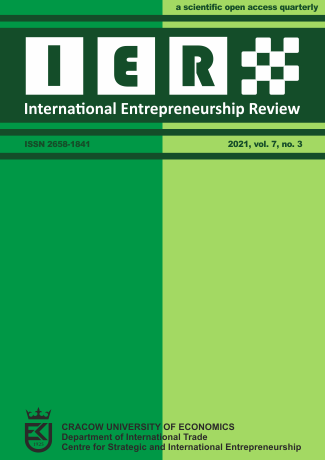Conditions and challenges for Polish-Chinese trade cooperation in high-tech goods

Abstract
Objective: The objective of this article is to discuss the contemporary conditions for Polish-Chinese cooperation in the area of trade in high-tech goods and to identify barriers to the development of cooperation between the two countries in order to achieve tangible economic benefits.
Research Design & Methods: This study is based on two research methods, which made it possible to obtain and analyse qualitative and quantitative data. The methods used included desk research of existing data and research in the form of individual in-depth interviews (IDIs). The desk research was carried out on the basis of data on the conditions for trade exchange, while the IDI survey was conducted on the basis of scenarios developed for this purpose, which were the basis for interviews with representatives of government.
Findings: The article presents research results on trade in high-tech goods with conclusions on the way forward. The result of the conducted research is the identification of the potential for the development of economic and political cooperation between Poland and China, which lies in the possibility of increasing trade in high-tech goods. This can be realised by increasing the involvement of Polish enterprises, especially start-ups, in export activities.
Implications & Recommendations: Poland and China have great potential for closer economic cooperation, which can bring economic benefits to each country.
Contribution & Value Added: The article compares quantitative data with qualitative data, which were obtained through in-depth interviews conducted with representatives of government administration.
Keywords
Poland, China, trade, international cooperation, high-tech
Author Biography
Celestyna Miłoś
Master of International Economics (2021, Cracow University of Economics, Poland). Her research interests include corporate internationalisation strategies, international business management and international marketing.
References
- Amal, M. (2021). EU-China Comprehensive Agreement on Investment (CAI): Looking through the European Un-ion’s perspective. Airlangga: Airlangga University.
- GUS (2021). Obroty handlu zagranicznego według krajów i kontynentów. Retrieved from http://swaid.stat.gov.pl/HandelZagraniczny_dashboards/Raporty_predefiniowane/RAP_SWAID_HZ_3_10.aspx on 4 June 2021.
- Białowąs, T. (2006). Rozwój handlu międzynarodowego po II wojnie światowej. Toruń: Wyd. A. Marszałek.
- Borkakoti, J. (1998). The Linder Hypothesis. In International Trade: Causes and Consequences. London: Springer International Publishing. https://doi.org/10.1007/978-1-349-27014-9_24
- Bossche, P. (2005). The Law and Policy of the World Trade Organization. Cambridge: Cambridge University Press.
- Brona, A. (2018). One Belt, One Road: new framework for international relations?. Polish Journal of Political Science, 4(2), 58-59.
- Gacek, Ł. (2018). Nowe źródła wzrostu gospodarczego Chin: wiedza i innowacje. Humanities Yearbooks, 66 (9), 11.
- Hołdak, K., & Konarzewska, A. (2007). Relations of the European Union with China. National Security Office.
- Jaklič, A. & Svetličič, M. (2019). China and Central and Eastern European Countries within ‘16+1’: Group or Bilateral Relations?. Entrepreneurial Business and Economics Review, 7(2), 83-100. https://doi.org/10.15678/EBER.2019.070205
- Kundera, J. (2018). Współczesne teorie wymiany międzynarodowej. Światowy handel po kryzysie 2008 r. In J. Kundera (Ed.), Gospodarka światowa po kryzysie 2008 r. Wrocław: Wydawnictwo Uniwersytetu Wrocławskiego.
- Lach, Z. (2014). Polska polityka w wymiarze subregionalnym. Przegląd Geopolityczny, 7, 17-19.
- Łoś-Nowak, T. (2009). Organizacje w stosunkach międzynarodowych. Istota – mechanizmy działania – zasięg. Wrocław: Wydawnictwo Uniwersytety Wrocławskiego.
- Nacewska-Twardowska, A. (2020). Factories Europe, Asia, and North America as the main production centers in the 21st century. International Entrepreneurship Review, 6(1), 63-76. https://doi.org/10.15678/IER.2020.0601.04
- Olesiuk, A., & Vashchenko, M. (2001). Międzynarodowe stosunki ekonomiczne – gospodarcze wyzwania XXI wieku. Warszawa: Key Text.
- Panda, R., Sethi, M., & Chaudhuri, S. (2016). Changing Paradigm in Trade Theories: A Review and Future Research Agenda. Indian Journal of Science and Technology, 9(46), 1-6. https://doi.org/10.17485/ijst/2016/v9i46/107291
- Portugal-Perez A., & Reyes J. D., & Wilson J. S. (2009). Beyond the Information Technology Agreement Harmonization of Standards and Trade in Electronics. Policy Research Working Paper, 2.
- Posner, M. (1961). International Trade and Technical Change. Oxford Economic Papers 13(3), 323-341. https://doi.org/10.1093/oxfordjournals.oep.a040877
- Rasiah, R. (2002). TRIPs and Capability Building in Developing Economies.Tokyo: The United Nations University.
- Stec, G. (2013). „Tradycyjna przyjaźń polsko-chińska” czy „niezłe perspektywy”? Stosunki polsko-chińskie od 1989 roku. Poliarchia, 1, 76-78.
- Świerkocki, J. (2004a). Zarys ekonomii międzynarodowej. Warszawa: PWE.
- Świerkocki, J. (2004b). Zarys międzynarodowych stosunków gospodarczych. Radom: Polwen.
- Szczudlik-Tatar, J. (2015). Polsko-chińskie „strategiczne partnerstwo”: w oczekiwaniu na wymierne rezultaty. The Polish Institute of International Affair, 101(1338), 1.
- United Nations Comtrade (2021). Trade Data. Retrieved from https://comtrade.un.org/Data/ on 4 June 2021.
- VerWey, J. (2019). Chinese Semiconductor Industrial Policy: Past and Present. Journal of International Commerce and Economics, 7, 13.
- Wach, K. (2018). Theoretical foundations for international entrepreneurship. In K. Wach (Ed.), Internationalization of firms in the perspective of international entrepreneurship. Warszawa: PWN, 63-95.
- Wnedt, J. (1997). Geopolityczne uwarunkowania rozwoju i zmian w przebiegu korytarzy tranzytowych w Europie Środkowej. Przegląd Geopolityczny, 28, 31-48.
- World Bank (2021a). China. Retrieved from https://data.worldbank.org/country/china on 4 June 2021.
- World Bank (2021b). Poland. Retrieved from https://data.worldbank.org/country/poland on 4 June 2021.
- World Bank (2021c). Tax. Retrieved from https://data.worldbank.org/indicator/TM.TAX.MRCH.%20WM.AR.ZS? locations=CN-PL on 4 June 2021.
- World Integrated Trade Solution. (2021). Top Exporters and Importers by country and region. Retrieved from https://wits.worldbank.org/CountryProfile/en/Country/WLD/Year/2018/TradeFlow/EXPIMP on 4 June 2021.
- WTO (2007). 2007 World Trade Report: Six Decades of Multilateral Cooperation, What Have we Learnt?. Geneva: WTO Publications, 207-220.
